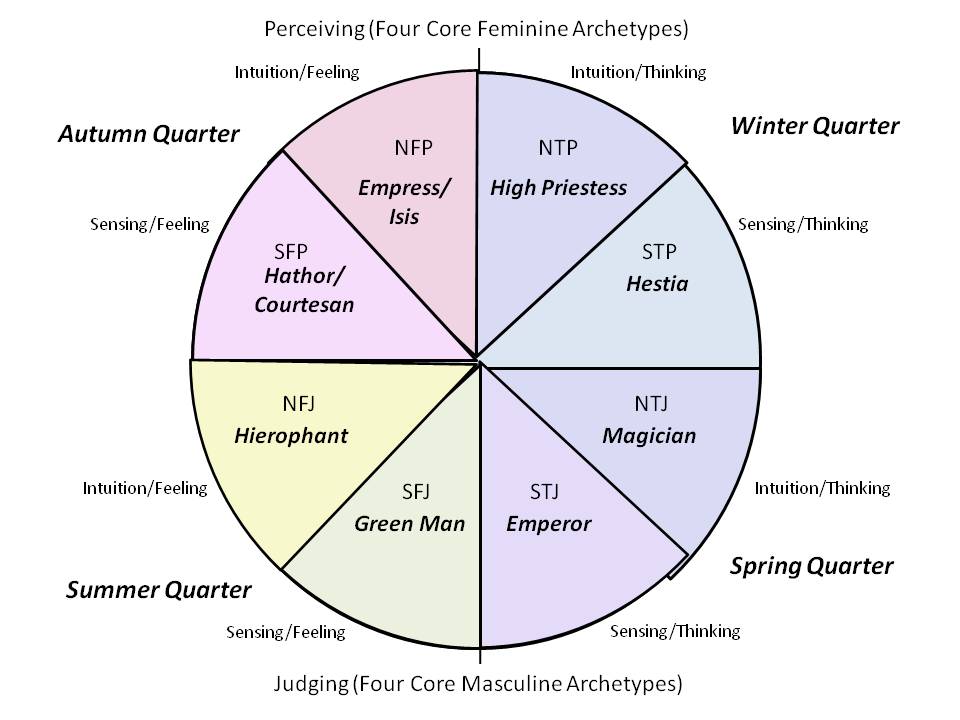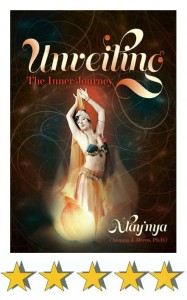Eight Core Power Archetypes Correspond with the Psychological Types
The previous post presented the basic diagram for the Unveiling archetypes. Here it is again, for easy reference.

Core archetypes octant chart – each archetype (each octant) corresponds to one of Jung’s Psychological Types (discounting the introversion/extroversion distinction).
There are three “dimensions” in this figure, and each corresponds to a specific aspect of our personalities.
The first “dimension” is the Thinking/Feeling distinction, shown as the top/bottom of this figure. The four octants (the “orange slices”) here that are in the top half are all those where the person is dominantly in a Thinking mode, and the bottom four are all “Feeling.”
One distinction that I’m particularly making here – somewhat unique to this approach – is that the “Feeling” corresponds to oxytocin-related states. That is, the “Feeling” is connected to how we feel good by connecting with others. The “others” can be children (particularly our own, especially if they’re young), our husbands or lovers, our girlfriends, or even our pet animals.
The “Thinking” is of course our logical, rational aspect.
The second main distinction is Judging/Perceiving, shown on the left/right sides of the diagram. The “Judging” is not about “judging” someone, as in saying to ourselves, “Oh, I don’t like her hair.” Rather, it is a desire to come to closure or completion on tasks. It is a “get-things-done” and “get the problem solved” mindset.
The “Perceiving” mode is a contrast to “Judging” in that it is open-ended. It is willing to tolerate ambiguity. It is willing to just be with something without having a firm, clear resolution.
Just for fun, I’ve put “Judging” on the left, and “Perceiving” on the right – not really trying to say “left” and “right” sides of the brain – but it’s a useful mnemonic!
Finally, within each of the four Judging/Perceiving and Thinking/Feeling quadrants, I’ve subdivided further into two more dimensions: Sensing/Intuition.
When we are in a “Sensing” mode, we are concerned with real, tangible things – things we can pick up, taste, feel. We can measure and analyze. Even abstract things – such as numbers on a spreadsheet – appeal to us when we are in “Sensing” mode, because we can be analytic about them.
In contrast, when we use “Intuition,” we make leaps of logic, connect beyond the obvious, and follow our gut. We interpret patterns, often very subliminally. While we may not be able to “analyze” our understanding – in terms of putting it under a microscope or counting up numbers of things – we trust this aspect, becuase we’ve learned that it serves us well.
Three dimensions, and a total of eight different combinations. (Thats 2x2x2=8.) That gives us the different Personality Types often used as a simpler form of the Jungian Psychological Types. It also gives us a handle for correlating the Unveiling archetypes with the Jungian system.
The basic organization of the archetype-to-Psychological-Type matching starts when we make a very simple distinction. We’re going to assign the entire “Judging” dimension to the masculine archetypes, and the “Perceiving” dimension to the feminine ones. Simplistic, yes. But we’re talking about archetypes here – knowing that each person combines multiple archetypes within their own being.
Second, we note that any feeling-oriented state is going to connect with a dominantly feeling-oriented archetype, and vice versa. This makes some of the matches very easy!
Thet next posting will walk through the assignments.
Very best wishes as discover and empower each of your core archetypes during your own inner journey!

Alay’nya – author of Unveiling: The Inner Journey
Alay’nya
(Alianna J. Maren, Ph.D.)
Author of Unveiling: The Inner Journey
You are the Jewel in the Heart of the Lotus. Become the Jewel!
The Unveiling Journey blog details the theory – archetypes, life journeys, integration.
To experience your own Journey in a structured, safe, and gentle (yet effective) setting, visit Alay’nya’s website, and consider either a workshop with Alay’nya or one-on-one coaching.
Resources
- To learn about upcoming workshops with Alay’nya, go to Alay’nya’s website.
- To study Oriental dance with Alay’nya, go to Alay’nya Studio – Instruction, and visit the Curriculum page (forthcoming) for class content and resources .
- To order an autographed and gift-wrapped copy of Unveiling, go to the Unveiling order page.
Connect with Alay’nya and the Unveiling Community
- Check out Alay’nya’s YouTube Channel
- Connect with Alay’nya on Facebook
- Follow Unveiling: The Inner Journey on Facebook
This blog series develops themes originally published in Unveiling: The Inner Journey, published by Mourning Dove Press.
Unveiling currently has twenty 5-star Amazon reviews, and has been recommended by luminaries:
- Dr. Christiane Northrup – “This book is delightful”
- Midwest Book Review, in Bethany’s Books – reviews by Susan Bethany – “highly recommended”
- Nizana al Rassan, writing for (the now out of circulation) iShimmy.com – “a fascinating read with so much wisdom and solid advice.”
Julie Marie Rahm, aka America’s Mindset Mechanic on Unveiling: The Inner Journey
What does Julie Rahm, America’s Mindset Mechanic and author of Handle Everything: Eight Tools You Need to Live Well and Prosper have to say about Unveiling: The Inner Journey?
Julie writes:
Unveiling is the definitive guidebook for women who want to experience lives of joy and fulfillment, and who just want to exhale into each day. Alay’nya reveals powerful, personal stories of her own life journey to fascinating womanhood, sensuality, and self-acceptance in ways that struck me like a velvet hammer. Her fresh approach to living illuminated my own bind spots. It is impossible to read Unveiling without awakening to new and possibly shocking self-awareness. For women ready to make real and lasting changes toward enlightenment and bliss, Unveiling is a must-read..”
Read this and more reviews of Unveiling: The Inner Journey.
|
Paper |
Kindle |
|||
Julie Marie Rahm, America’s Mindset Mechanic
Check out Julie Marie Rahm!
Julie Marie Rahm, America’s Mindset Mechanic and author of Handle Everything: Eight Tools You Need to Live Well and Prosper and also Military Kids Speak (great for parents, teachers, and coaches of military kids) uses a great technique that can help you clear energy blockages, ranging from those from this life through the influence of your ancestral karma. Connect with Julie at info (at) americasmindsetmechanic (dot) com to learn more about how she can help you.
Books by Julie Marie Rahm, America’s Mindset Mechanic
|
Kindle
|
Kindle
|
|||
Copyright (c) 2013, Alay’nya (Alianna J. Maren, Ph.D.). All rights reserved.
Blog originally posted December 28, 2011. Revised and updated, October 22, 2013.
Related Posts: Archetypal Roles and Everyday Life
- Six Top Blog Posts for The Unveiling Journey – Six years, more than 100 posts, and six are the all-time winners. See the countdown, and find which one I recommend the most!
- Hathor or Hierophant – Who’s on Top? – More than just discussing two specific core power archetypes (pleasure-goddess Hathor and guru/guide Hierophant), this addresses our internal dynamics as our masculine and feminine archetypes each vie for power.
- Unveiling “Archetypes” and Franklin-Covey “Roles” – A Useful Synergy and Connection – Practical musings – the Franklin-Covey Day-Planner system has us identifying various “roles” and making sure that we give time to each – we can cultivate each of our inner archetypes by matching them with our “roles” and planning time/activities for each role.

